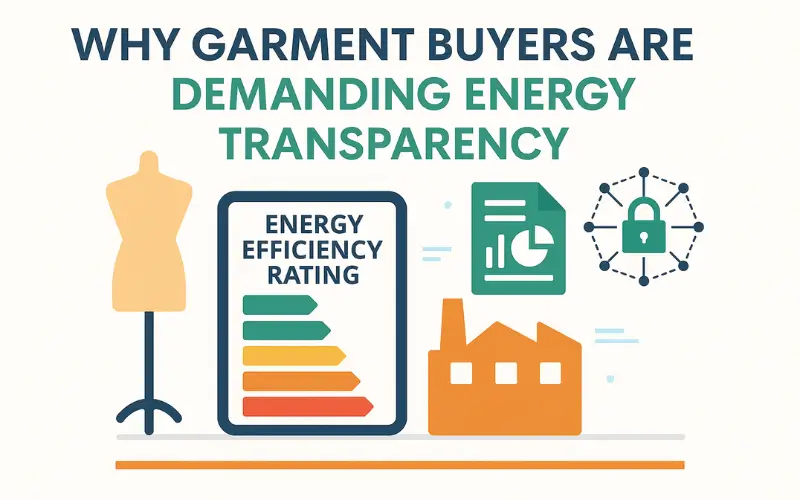In today’s global garment industry, sustainability isn’t just a buzzword—it’s a growing demand from buyers, consumers, and regulators alike. One of the most significant trends reshaping the industry is energy transparency—the clear disclosure of energy consumption and efficiency practices by factories. Buyers are no longer just evaluating product quality or price; they are scrutinizing how garments are produced, with a particular focus on environmental impact and energy use.
This shift is driven by multiple factors. International buyers are under increasing pressure from consumers who value eco-friendly products, and governments are implementing stricter regulations around energy efficiency and carbon emissions. By insisting on energy transparency, buyers can make informed sourcing decisions, reduce supply chain risks, and align themselves with sustainability goals.
For garment manufacturers, embracing energy transparency is not just about compliance—it’s an opportunity to optimize operations, reduce costs, and gain a competitive edge in a market where sustainability increasingly drives purchasing decisions. This article explores why buyers are demanding energy efficiency, the benefits of transparency, the tools enabling it, and the steps manufacturers can take to meet these evolving expectations.
Understanding Energy Transparency in the Garment Sector
Defining Energy Transparency
Energy transparency refers to the clear, accessible disclosure of a factory’s energy consumption, efficiency measures, and carbon footprint throughout its production processes. In the garment sector, this means that manufacturers openly share information on how much energy is used at different stages—such as spinning, weaving, dyeing, and finishing—and what steps are taken to minimize waste or switch to renewable sources.
Energy transparency is essential for several reasons:
- Accountability: Buyers can hold manufacturers accountable for their environmental impact.
- Informed Decision-Making: Transparent energy data allows buyers to choose suppliers who align with their sustainability goals.
- Benchmarking and Improvement: Factories can compare their energy efficiency against industry standards and identify areas for improvement.
By providing detailed energy data, factories not only demonstrate responsible practices but also gain credibility in the eyes of environmentally conscious buyers.
The Role of Energy Efficiency in Sustainable Fashion
Energy efficiency goes hand-in-hand with sustainability. Reducing energy consumption in garment manufacturing:
- Lowers Carbon Emissions: Efficient machinery and optimized processes directly decrease greenhouse gas emissions.
- Reduces Operational Costs: Less energy use means lower electricity and fuel bills, improving overall profitability.
- Enhances Brand Reputation: Brands sourcing from energy-efficient factories can market themselves as sustainable, attracting eco-conscious consumers.
In today’s market, energy efficiency is not optional—it’s a competitive differentiator. Buyers increasingly demand proof of energy-conscious practices as part of their corporate social responsibility (CSR) requirements and ESG (Environmental, Social, Governance) commitments.
Why Buyers Are Prioritizing Energy Transparency
Regulatory Pressures and Compliance
Global regulations are increasingly shaping buyer expectations in the garment industry. Governments and international bodies are implementing stricter energy efficiency and carbon emission standards, requiring factories to monitor and report their energy use.
Key aspects include:
- Carbon Reporting Requirements: Many countries now mandate reporting of greenhouse gas emissions, directly linking energy use to compliance obligations.
- Energy Audits and Certifications: Certifications like ISO 50001 (Energy Management System) or LEED (Leadership in Energy and Environmental Design) demonstrate that a factory adheres to recognized energy efficiency standards.
- Supply Chain Regulations: Buyers sourcing from multiple countries must ensure that suppliers comply with local regulations to avoid fines, trade restrictions, or reputational risks.
By insisting on energy transparency, buyers reduce the risk of non-compliance and align their supply chains with global regulatory frameworks.
Consumer Demand for Ethical Practices
Modern consumers are increasingly conscious of how their clothing is produced. Brands that fail to demonstrate sustainable practices may face backlash or reduced sales. Buyers respond to this trend by prioritizing factories that provide:
- Clear Energy Usage Data: Showing measurable steps toward reducing environmental impact.
- Sustainability Certifications: Validating claims of energy efficiency and ethical production.
- Proof of Continuous Improvement: Demonstrating that energy efficiency is an ongoing goal, not a one-time initiative.
This pressure ensures that energy transparency isn’t just about internal reporting—it directly impacts marketability and consumer trust.
Risk Mitigation and Supply Chain Resilience
Energy transparency also helps buyers manage operational and reputational risks:
- Identifying Vulnerabilities: Factories with high energy consumption or dependence on non-renewable sources are exposed to energy price fluctuations and supply disruptions.
- Reducing Supply Chain Disruptions: Transparent energy practices allow buyers to anticipate potential bottlenecks caused by power shortages or inefficient operations.
- Enhancing Long-Term Sustainability: By working only with energy-conscious suppliers, buyers strengthen the resilience and sustainability of their entire supply chain.
In essence, energy transparency is a tool for both compliance and strategic supply chain management. It allows buyers to make more informed decisions and maintain consistent, reliable sourcing operations.
The Impact of Energy Transparency on Garment Manufacturers
Operational Benefits
Adopting energy transparency can bring tangible operational advantages for garment manufacturers:
- Cost Reduction: Monitoring and optimizing energy usage reduces electricity, fuel, and water costs. For example, switching to energy-efficient lighting or machinery can lower monthly utility bills significantly.
- Process Optimization: Transparent energy tracking highlights inefficiencies in production lines, enabling manufacturers to streamline operations and minimize waste.
- Enhanced Productivity: Efficient energy management ensures that machines run reliably and downtime is reduced, improving overall output.
By integrating energy transparency into daily operations, manufacturers not only satisfy buyer demands but also improve their bottom line.
Access to New Markets and Partnerships
Energy transparency opens doors to new business opportunities:
- Global Market Access: International buyers often require proof of sustainability before sourcing. Factories that can provide energy data are more likely to be selected.
- Premium Partnerships: Brands committed to ESG goals prefer suppliers demonstrating measurable energy efficiency.
- Competitive Advantage: Transparent energy practices distinguish factories from competitors, helping them win contracts and long-term partnerships.
Essentially, energy transparency enhances credibility, making manufacturers more attractive to eco-conscious buyers and global brands.
Challenges and Barriers
Despite its benefits, implementing energy transparency is not without hurdles:
- High Initial Costs: Installing monitoring equipment, energy management systems, or renewable energy sources requires upfront investment.
- Data Collection Complexity: Gathering accurate energy data from all production stages can be technically challenging.
- Knowledge and Training Gaps: Factory staff may need training to understand energy management systems and sustainability reporting.
- Resistance to Change: Some manufacturers may be reluctant to disclose energy usage due to concerns about competitiveness or exposing inefficiencies.
To overcome these barriers, manufacturers can adopt phased implementation, invest in staff training, and leverage government or NGO incentives for energy efficiency improvements.
Case Studies: Leading the Way in Energy Transparency
Bangladesh’s Green Factory Movement
Bangladesh, one of the world’s largest garment exporters, has become a global example of energy-conscious manufacturing. Over the past decade, the country has seen a surge in factories adopting energy-efficient practices and pursuing certifications that validate their sustainability efforts.
Key highlights:
- Green Factory Certification: As of 2024, Bangladesh has 186 factories certified as green by the U.S. Green Building Council’s LEED (Leadership in Energy and Environmental Design) standard, up from only three in 2014.
- Energy Efficiency Measures: Factories implement solutions such as solar panels, efficient HVAC systems, and advanced lighting to reduce energy consumption.
- Government and Industry Support: The Bangladesh Garment Manufacturers and Exporters Association (BGMEA) encourages energy audits, renewable energy adoption, and training programs to help factories meet international standards.
This movement demonstrates that with structured support and clear incentives, manufacturers can achieve significant improvements in energy transparency while gaining access to buyers seeking sustainable suppliers.
Global Brands Setting Standards
Several international apparel brands are leading the way in energy transparency, setting high expectations for their suppliers:
- H&M and Zara: Require suppliers to report detailed energy consumption and sustainability metrics, influencing factory upgrades worldwide.
- Levi’s and Patagonia: Invest in supplier training and energy efficiency programs, using digital tools to track energy use and verify sustainability claims.
- Impact on Suppliers: Factories meeting these energy transparency standards often gain long-term contracts, premium pricing, and enhanced market credibility.
These examples show that buyers are not only requesting energy transparency—they are actively supporting factories in achieving it, creating a collaborative approach toward sustainable fashion.
Tools and Technologies Enabling Energy Transparency
Digital Product Passports
Digital Product Passports (DPPs) are emerging as a powerful tool for enhancing energy transparency in the garment industry. They function as digital records containing all relevant information about a product, including:
- Energy Consumption: Details of energy used during production, including renewable vs. non-renewable sources.
- Carbon Footprint: The total emissions generated across the product’s lifecycle.
- Materials and Sustainability Certifications: Data verifying eco-friendly sourcing and compliance with industry standards.
Benefits for Buyers and Manufacturers:
- Buyers can make informed sourcing decisions quickly.
- Manufacturers can showcase their sustainability credentials to attract eco-conscious clients.
- Enables easier auditing and reporting for regulatory compliance.
Energy Management Systems (EMS)
Energy Management Systems (EMS) are software platforms that track, monitor, and optimize energy usage in factories. Key features include:
- Real-Time Monitoring: Continuous tracking of electricity, gas, and water usage.
- Analytics and Reporting: Identification of inefficiencies, energy peaks, and opportunities for cost savings.
- Automation: Integration with machinery to optimize operational schedules and reduce wastage.
Impact:
- Factories achieve measurable reductions in energy costs.
- Buyers gain confidence in the reliability and efficiency of the supply chain.
- EMS helps in achieving certifications like ISO 50001 for energy management.
Blockchain for Supply Chain Transparency
Blockchain technology is revolutionizing supply chain transparency, including energy reporting. Key applications include:
- Immutable Records: Energy data recorded on the blockchain cannot be altered, ensuring trust and credibility.
- Traceability: Buyers can track energy usage from raw material sourcing to final garment production.
- Integration with IoT and EMS: Data from machines and sensors can be automatically logged on blockchain, creating a seamless transparency ecosystem.
Benefits:
- Reduces disputes over energy data accuracy.
- Strengthens supplier-buyer relationships through verified reporting.
- Encourages continuous improvement by making energy performance visible to all stakeholders.
This section demonstrates how technology enables practical energy transparency, making it easier for both manufacturers and buyers to collaborate on sustainability goals.
The Future of Energy Transparency in the Garment Industry
Emerging Trends
The garment industry is rapidly evolving, and several trends are shaping the future of energy transparency:
- Increased Regulatory Pressure: Governments worldwide are implementing stricter carbon and energy reporting requirements, pushing factories to adopt transparent practices.
- Integration of Advanced Technologies: IoT devices, AI, and blockchain will make real-time energy tracking and automated reporting standard across production lines.
- Buyer-Driven Standards: Leading global brands are likely to increase their energy transparency requirements, influencing suppliers worldwide.
- Consumer Awareness: Eco-conscious consumers will continue to demand information on the environmental impact of garments, making transparency a key factor in purchasing decisions.
These trends indicate that energy transparency will become a baseline expectation, rather than a competitive differentiator, in the coming years.
Preparing for the Future
Garment manufacturers can take proactive steps to align with future energy transparency expectations:
- Invest in Energy Management Systems: Implement EMS to track, analyze, and optimize energy consumption.
- Adopt Renewable Energy Sources: Incorporate solar, wind, or other clean energy sources to reduce carbon footprint.
- Train Staff and Management: Ensure all employees understand energy efficiency practices and reporting requirements.
- Collaborate with Buyers: Work closely with brands to meet transparency standards and participate in sustainability programs.
- Certifications and Audits: Obtain certifications like ISO 50001 or LEED, and conduct regular energy audits to validate performance.
By taking these steps, manufacturers not only comply with future standards but also gain a strategic advantage in attracting eco-conscious buyers.
Conclusion
Energy transparency is no longer optional in the garment industry—it is a critical expectation from buyers, regulators, and consumers alike. By openly sharing energy consumption data, factories can demonstrate sustainability, improve operational efficiency, and strengthen their market position.
Buyers prioritize energy transparency to mitigate risks, comply with regulations, and meet consumer demand for ethical practices. For manufacturers, embracing transparency unlocks operational benefits, access to new markets, and stronger partnerships with leading global brands.
As the industry evolves, adopting advanced technologies, renewable energy, and robust reporting systems will be key for factories to stay competitive. Manufacturers who act proactively will not only meet buyer demands but also play a significant role in shaping a sustainable and resilient garment supply chain.
FAQs
What is energy transparency in the garment industry?
Energy transparency is the clear disclosure of a factory’s energy consumption, efficiency measures, and carbon footprint throughout production.
How can energy transparency benefit garment manufacturers?
It helps reduce costs, improve operational efficiency, gain certifications, access new markets, and attract eco-conscious buyers.
What tools are available to track energy use in garment factories?
Factories can use Energy Management Systems (EMS), Digital Product Passports (DPPs), and blockchain technology to monitor and report energy usage.
How does energy transparency impact buyer decisions?
Transparent energy data allows buyers to select suppliers aligned with sustainability goals, regulatory compliance, and ethical standards.
What are the challenges in implementing energy transparency?
Common challenges include high initial costs, complex data collection, training requirements, and resistance to change within factories.




